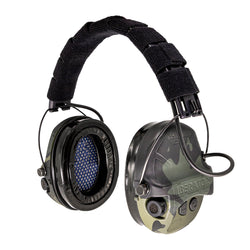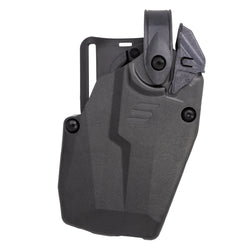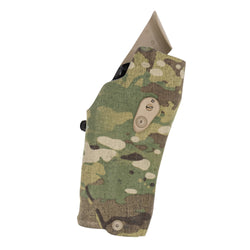I spent my Olympic career shooting stationary in the range at targets 50 meters away. Yes, my heart rate was 180 bpm. Yes, I’d skied several miles to get there, but was stationary when I took my shots.
Then came 3-gun and “running and gunning.” The first time I shot on the move, I felt like a newborn deer—wobbly, awkward, hyper-aware of every step. But I knew one thing: Movement keeps you in the game and alive.

Learning to Move and Shoot
When I transitioned from Olympic-style shooting to 3-gun, I quickly realized that accuracy while moving was a whole new ball game.
At first, my draw was clumsy. My muzzle wobbled and my shots were off target. But I kept at it—knees bent, torso stable, feet rolling heel-to-toe. It didn’t take long before my shots began landing clean, even in motion.
Start Simple, Then Advance
Set up cones or markers. Walk forward and shoot. Then, try lateral movement. Eventually, add reloading or transitions. The trick is to move with control, not speed.
Dry Fire is your best friend here. Film yourself. Watch how your sights align with the target. You’ll see where you’re overcorrecting—or bouncing too much. The key is to minimize movement. Yes, this seems counterproductive to “moving,” but the heel-to-toe movement will help to reduce your movement.
Muscle memory is key. Your practice will set the outcome, so repetition is essential until everything feels comfortable and not awkward. Start slow and simple with your drills, then add speed and difficulty as you improve.

Drawing While Moving
Drawing is not just about being fast. It’s about being smooth. I practiced drawing from concealment while retreating or side-stepping. It forced me to think ahead, manage balance and movement, and maintain muzzle control.
Draw also while getting into and out of awkward positions. This could be similar to replicating getting into or out of a vehicle, your bed, or a place of concealment. Be creative with your training.
Train for Real Scenarios
Defensive shooting often happens in motion. Maybe you’re retreating from a threat. Perhaps you’re seeking cover. Either way, you can’t freeze. So train like it matters—because it does.
Competitions are a great way to add stress and movement. If competition isn’t your thing, try putting pressure on your training. Have progressively harder drills during a session, where you have to meet a certain goal to move on to the next drill. If you don’t meet that goal, you start over from the beginning. This adds pressure and other emotions, such as frustration. Stress your system. That’s how confidence grows.
Mobility gives you an edge. It buys you time, space, and control. Get moving, keep training, and make dynamic shooting second nature.









